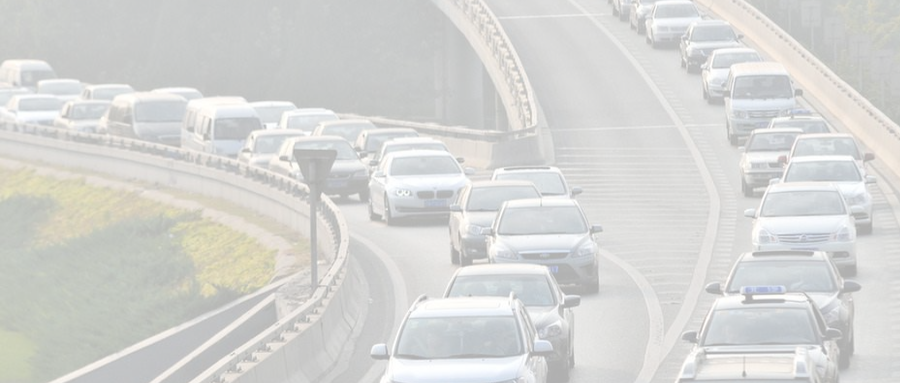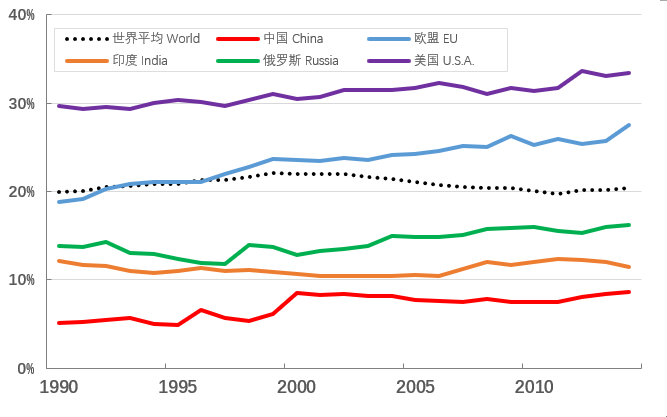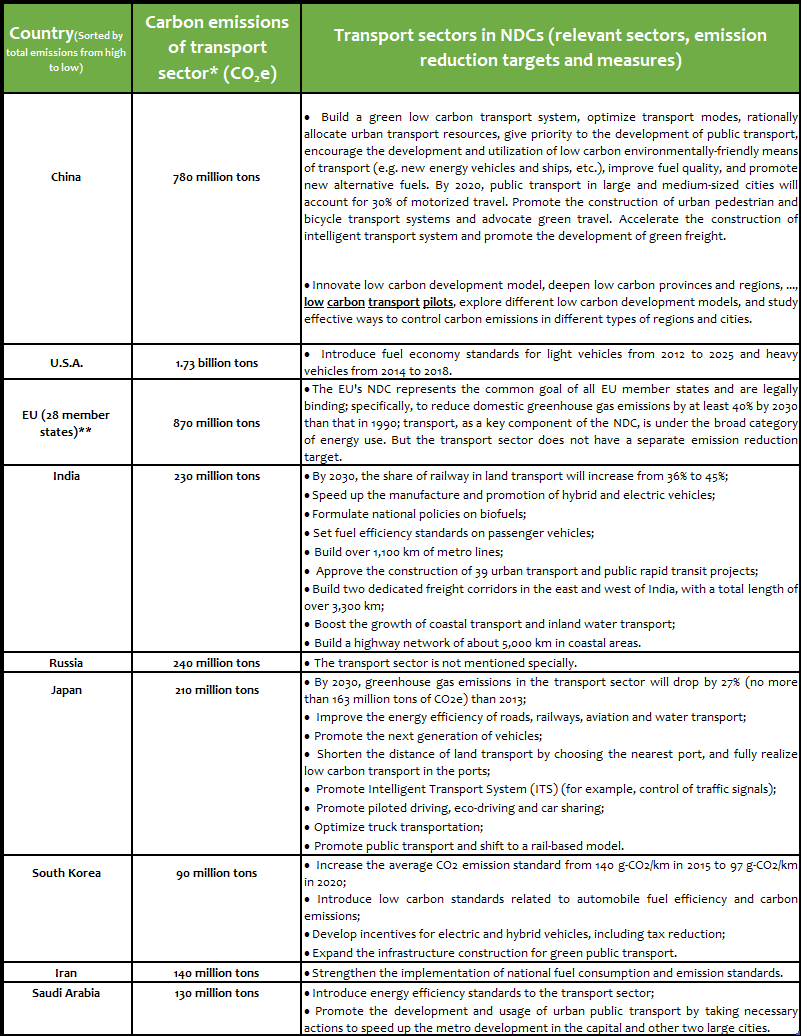

China’s climate commitment under the Paris Agreement is ambitious through horizontal comparison among the emerging economies. The Nationally Determined Contributions (NDC) also mentions the goal of peaking emissions around 2030, but China is supposed to take more responsibilities in the context of global temperature rise of 2℃ or even 1.5℃. In this case, as the world's largest emitter, China's NDC has been labeled as "highly insufficient"1.
Therefore, it is necessary to carefully analyze the emission reduction potentials and future development trends of various sectors under the control of the total emission target, so as to provide necessary support for future NDC updates in China. According to the statistics on carbon emissions in China, the proportion of carbon emissions in the transport sector ranks third2, and is now increasing year by year at a fast rate, especially in the road traffic sector. As the number of private cars grows rapidly due to urbanization, the resultant growth rate of emissions cannot be ignored, and has also become the main obstacle to low carbonization of the transport sector.
Carbon emission status of transport sector in China and horizontal comparison
According to the International Energy Agency (IEA), the carbon emission of the transport sector in China was 780 million tons of carbon dioxide in 2014, accounting for 8.6% of China's total energy-related emissions, which is still much lower than the world average of 20%. Among the world's five major emitters (regions), the United States and the European Union account for about 30% respectively; India is also slightly higher than China, accounting for 11.5% in 2014.
Figure 1: Proportion of carbon emissions in the total carbon emissions for the transport sector of the five major emitter

Source: World Bank DataBank CO2 emissions from transport (% of total fuel combustion). Link:https://data.worldbank.org/indicator/EN.CO2.TRAN.ZS
The specific trend in China is that there is a period of rapid growth after 1998, but it tends to be stable after 2000, accounting for about 8%. As the growth rate of China's total carbon emissions slows down and that of energy consumption in the transport sector maintains a high level, the proportion of transport emissions in the future will be closer to the world average.
Commitments on the transport sector in NDCs of different countries
The IPCC Fifth Assessment Report (AR5) proposes a set of strategies for reducing the greenhouse gas emission intensity of the transport sector, including the implementation of "Avoid" and "Shift" strategies to complement the "Improve" measures3. For some countries, their NDCs can reflect how to balance these strategies, for example, Jordan's NDC, which includes both "Avoid" strategy (e.g. vehicle restrictions, congestion charges, etc.) and "Shift" strategy (e.g. improving public transport, encouraging cycling and walking, etc.) and "Improve" strategy (e.g. improving fuel efficiency, promoting fuel low carbonization, increasing electric travel ratio, etc.).
As urbanization and industrialization in different countries are in different stages, according to the emission inventories, the urban carbon emissions in developed countries are mainly from the construction sector, while those in the emerging countries are mainly from the transport sector, and those in the fast-growing developing countries are mainly from the industrial sector4. As a result, different countries have different priorities on their NDCs, and these factors need to be taken into account when making the commitments on the transport sector.
Nearly three-quarters of the countries that have submitted NDC or INDC have explicitly mentioned the emission reduction measures for the transport sector, and some organizations have analyzed these measures. In addition to distinguishing different transport modes, the country category (Annex-I vs. Non-Annex I) has also been indicated. In terms of transport modes, measures in the NDCs are obviously biased towards passenger transport, and there are insufficient considerations for freight transport, especially for Non-Annex I countries. Among other passenger transport measures, urban transport and heavy rail are more likely to be mentioned in the NDCs. In contrast, high speed rail, shipping and aviation receive far less attention, while the measures to reduce emissions by walking and cycling are mentioned by more than 10 countries.
Figure 2: Analysis of NDCs in covering transport sector

Source: Transport and Climate Change: How Nationally Determined Contributions can Accelerate Transport Decarbonization, By Cornie Huizenga, Secretary General and Karl Peet, Research Director, Partnership on Sustainable, Low Carbon Transport
Note: Annex I countries refer to the contracting states that have established a special commitment to reduce greenhouse gas emissions in the United Nations Framework Convention on Climate Change (UNFCCC) (1992) and the Kyoto Protocol, which are basically developed countries; the exceptions are Turkey and Belarus, which are listed in Annex I, but did not make emission reduction commitments under the Kyoto Protocol. Non-Annex I countries refer to all other contracting states other than Annex I countries. Review of China's
NDC and comparison with other major emitters
As China's international commitment on climate change, NDC reflects a country's ambitions for climate action, so it is necessary to analyze China's NDC and compare it with those of other major emitters, especially carbon emissions in the transport sector that this article focuses on, which will help us understand what aspects of China's transport sector need to be strengthened for future NDC updates.
China’s climate commitment on the transport sector is mentioned in the NDC submitted5, reflecting China's emphasis on the development of low carbon transport. Although the emission control measures mentioned in the NDC are broad, they are also consistent with domestic low carbon transport development policies. In other words, existing domestic low carbon transport planning, policies and measures are refined.
According to the latest emission data (2017), more than 70% of global carbon emissions are concentrated in 10 economies6. However, due to the inconsistent development levels of these countries and regions, the transport modes are quite different, so the proportion of traffic emissions in their respective total emissions is also different.
Table1: Summary of specific measures for the transport sector in the NDCs of the world's major emitters

*Data in 2014; ** Although Germany, which is not included in this table, is the seventh largest emitter, its NDC is consistent with that of the European Union.
Reference: Transport in Nationally Determined Contributions (NDCs) Lessons learnt from case studies of rapidly motorising countries by GIZ 2017.
Comparing the commitments in transport made by major emitters listed in the table above, the U.S.A. and Iran have only proposed one measure in fuel efficiency and standards, while Saudi Arabia has mentioned the development of public transport on this basis. Although the European Union has set emission reduction targets, there is no separate limit to the total emissions in the transport sector and the practical implementation is based on the actual situation of member states. In general, freight-related emission reduction measures need to be strengthened in the NDC.
In Japan and South Korea with a high proportion of public transport travel, emphasis is placed on “Improve” strategy, involving energy efficiency and emission standards. Japan has made a very comprehensive low carbon overall strategy for transport sector in the NDC, proposing the total emission control of the transport sector by 2030, with a special mention of sub-sectors such as aviation and shipping, and detailing the low carbon strategy for ports. It’s worth noting that Japan is the only country that has proposed in the NDC to encourage “eco-driving” based on the change in behavioral patterns. South Korea is the only country that has proposed to include the average CO2 emission standard into the NDC and reach 97 g-CO2/km by 2020, which is close to 95 g-CO2/km specified by the European Union.
As two major developing countries, China and India, due to their underdeveloped public transport, especially India, have also emphasized the “Shift” strategy in the NDC. India has also proposed many quantitative indicators, mainly for railways and roads. In China's NDC, “Avoid” strategy for the transport sector is not separately mentioned, while there is a mention of “giving priority to the development of public transport, encouraging the development and utilization of new energy vehicles and ships, promoting the construction of urban pedestrian and bicycle transport systems, etc.” in terms of the “Shift” strategy, and "improving fuel quality, promoting new alternative fuels, accelerating the construction of intelligent transport system, promoting the development of green freight, etc." in terms of the "Improve" strategy. It is worth noting that China has proposed a low carbon transport pilot project, which is also an exploration with Chinese characteristics and helps to develop a unique and easily replicable low carbon transport development model. The disadvantage is that it only mentions the “research on effective ways to control carbon emissions in different types of regions and cities”, instead of specific emission reduction target for the transport sector and longer-term commitment.
Conclusion:China shall strengthen the commitment on the transport sector when the NDC is updated.
2019 is an important year, because by the end of 2020, as agreed in the “Talanoa Dialogue”, the parties to the UNFCCC will have the opportunity to submit new or updated NDCs7 before 2020, and countries will also need to submit low emission strategies by 2050. Based on the comparison of NDCs between China and other major emitters in the world, we hereby suggest that China strengthen the commitment on the transport sector before the NDC is updated by following means:
Specifying the year of carbon emission peak in transport sector
At present, the carbon emission peak in the transport sector is not mentioned in China’s NDC. However, it is necessary for the transport sector where the emission growth rate is still relatively high and can at least guide the future development direction of low carbon transport in China and provide policy-level support for the "Shift" strategy by limiting total emissions. In addition, for the emission of non-commercial transport, when developing transport emission path and control policies, a fuller coverage of emitters shall be taken into consideration, because the national emission reduction plan neither covers this emission sector nor proposes any specific emission reduction target8.
Improving commitment on electric vehicle development
“As for electric vehicles, by 2020, public transport in large and medium-sized cities will account for 30%9 of motorized travel” mentioned in the existing NDC shall be updated as appropriate. China shall not only limit the coverage to public transport vehicles, but also pay more attention to the electrification of private cars and focus on longer term, such as 2030 and 2035. In the exposure draft of New Energy Automobile Industry Development Plan (2021-2035)10, the targets for the proportion of electric vehicles in the future are mentioned. In the formulation of these targets, climate change factors shall be taken into account and reflected in China's NDC as much as possible.
Taking more account of aviation emissions
Although the policies related to carbon emissions in the aviation industry mainly depend on the Carbon Offsetting and Reduction Scheme for International Aviation (CORSIA) implemented under the leadership of the International Civil Aviation Organization, the system itself does not directly reduce carbon emissions, but neutralizes emissions exceeding the limit. Considering the rapid growth momentum of China's air travel, especially international air travel, China shall not only simply carry out carbon neutralization, but also present specific planning targets in aviation energy efficiency and aviation biofuel. For domestic aviation, it is also necessary to present specific plans and schedules when updating NDC to explain how to take the emissions of the aviation sector into account in China's carbon market in the future.
Emphasizing the relationship between transport and health
Since lower carbon emissions from the transport sector will reduce the emissions of pollutants from car exhaust, some countries will also include the air pollution-oriented measures into NDC, because measures to reduce air pollution will often bring about direct or indirect carbon emission reduction. Therefore, it is also necessary for China to review the contribution of healthy exhaust control policies or congestion mitigation measures to carbon emission reduction. This will help to determine if a faster mode shift from automobiles to public transport or technological improvement from gasoline/diesel vehicles to electric vehicles is required.
Coordination between government departments and between the central and local governments
In addition to the extensive coordination between relevant national government departments (energy, transport, planning, environment, industry, etc.), local governments can also participate in the formulation of NDC for the transport sector, because they all have the required professional knowledge and are directly affected by the implementation of these specific measures.
Specifying fuel economy standard in the NDC
The improvement of energy efficiency in the transport sector requires the implementation of stricter vehicle fuel economy standards, which is not reflected in China's NDC. However, since January 1, 2016, China has already implemented the national standard of Fuel consumption limits for passenger cars and is expected to introduce stricter standards after 2020. Therefore, it is necessary to state this in the NDC.
Strengthening the legal norms and standard system related to low carbon transport
If possible, a schedule for the issuance of carbon emission standards for passenger cars shall be provided, and the carbon emission reductions corresponding to the implementation of standards can be calculated accordingly, which will be conducive to setting the total amount control target of the transport sector in the NDC. The formulation of carbon emission standards requires policy makers to consider fuel economy standards from a macro perspective and to strengthen the integration of relevant legal norms and standard system for low carbon transport.
References
1. Climate Action Tracker, China profile. Link: https://climateactiontracker.org/countries/china/
2. Development of Low Carbon Transport in China, edited by He Zengrong, 2018, Economic Daily Press.
3.Ralph Sims et al., 2014: Transport. In: Climate Change 2014: Mitigation of Climate Change. Contribution of Working Group III to the Fifth Assessment Report of the Intergovernmental Panel on Climate Change. Link: https://www.ipcc.ch/site/assets/uploads/2018/02/ipcc_wg3_ar5_chapter8.pdf
4. Climate Change and Low-carbon City Planning (2nd edition), edited by Gu Chaolin, 2013, Southeast University Press.
5. China's NDC documents submitted to deal with climate change, National Development and Reform Commission (NDRC), 2015. Link : http://www.ndrc.gov.cn/xwzx/xwfb/201506/t20150630_710204.html
6.Fossil CO2 emissions of all world countries - 2018 Report. Link: https://ec.europa.eu/jrc/en/publication/fossil-co2-emissions-all-world-countries-2018-report
7.4 Reasons for Countries to Enhance Their NDCs by 2020, WRI, 2017. Link: https://www.wri.org/blog/2017/11/4-reasons-countries-enhance-their-ndcs-2020
8.Chai Qimin, Fu Sha, Wen Xinyuan. “Research on the Path of Implementation of Nationally Determined Contributions in China” [J]. Journal of Environmental Economics, 2019,4(02):110-124.
9.Enhanced Actions on Climate Change: China's Nationally Determined Contributions, 2015, the former Department of Climate Change of the National Development and Reform Commission. Link :https://www4.unfccc.int/sites/ndcstaging/PublishedDocuments/China%20First/China%27s%20First%20NDC%20Submission.pdf
10.Exposure of the exposure draft of the New Energy Automobile Industry Development Plan (2021-2035), Link :https://www.d1ev.com/news/zhengce/101363




